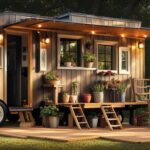Beginners Guides
How To Build A Cheap Tiny House
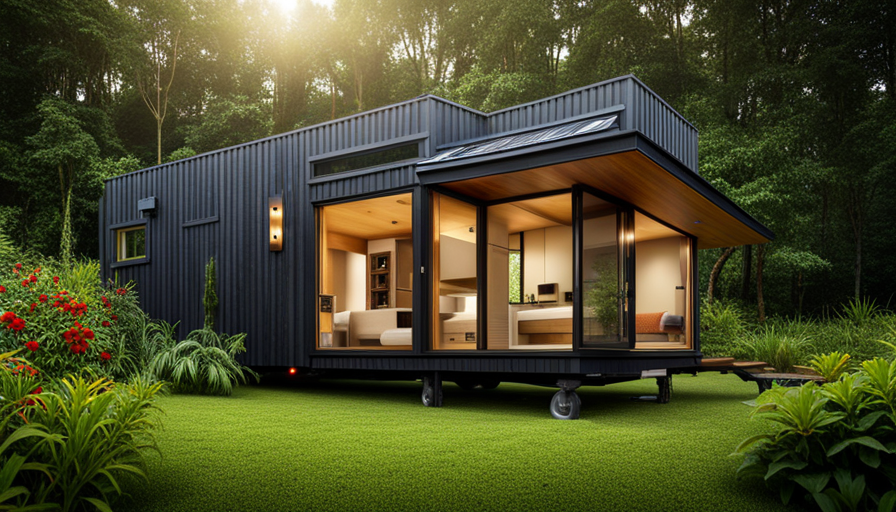
Interested in constructing your own small home, are you? Fortunately, I’m available to assist you in navigating the creation of an affordable and snug haven you can call your own.
Forget about those overpriced mansions and extravagant homes, because it’s time to downsize and embrace the minimalist lifestyle.
In this article, I’ll show you how to build a cheap tiny house that doesn’t skimp on comfort or style. We’ll cover everything from determining your budget and design preferences to finding the perfect location and obtaining necessary permits.
I’ll even spill the beans on where to source affordable and sustainable materials, because who said being environmentally conscious had to break the bank?
But hold on tight, because building a tiny house requires attention to detail and precision. We’ll discuss the right foundation and structure, as well as the installation of basic utilities and systems. And of course, we can’t forget about safety and insulation – after all, you want your tiny home to be snug as a bug in a rug.
So buckle up and get ready to embark on an adventure of DIY construction. By the end of this article, you’ll be well-equipped to build your very own affordable and charming tiny house.
Let’s get started!
Key Takeaways
- Embrace a minimalist lifestyle and downsize to build a cheap and cozy tiny house.
- Pay attention to detail and precision in the building process to ensure a high-quality result.
- Choose affordable and sustainable materials for construction, considering salvaged materials, local resources, and sustainable alternatives.
- Design an efficient layout and incorporate innovative storage solutions to optimize space in a compact area.
Determine Your Budget and Design Preferences
Before you start building your cheap tiny house, it’s important to determine your budget and design preferences.
Determining the budget is the first step in the process. Take into account your financial situation and how much you’re willing to invest in this project. Consider all the costs involved, including materials, labor, permits, and any additional expenses that may arise. Research the market to get an idea of the average cost of building a tiny house, and adjust your budget accordingly.
Next, finding your design preferences is crucial. Think about the layout, style, and functionality you want for your tiny house. Consider your lifestyle and how you’ll be using the space. Look for inspiration online, visit model tiny houses if possible, and create a list of features and elements that are important to you. This will help guide you throughout the design and construction process.
Once you have determined your budget and design preferences, it’s time to find the perfect location for your tiny house. This is a crucial decision that will impact your overall experience. Consider factors such as zoning regulations, access to utilities, proximity to amenities, and the overall ambiance of the area. By carefully considering these factors, you can ensure that your tiny house will be situated in an ideal location that meets your needs and enhances your lifestyle.
Find the Perfect Location
When looking for the ideal spot, you’ll want to envision a picturesque landscape that captures the essence of your dream getaway. Finding land for your cheap tiny house can be a challenging task, but with careful planning and research, you can find the perfect location.
Consider the following factors when searching for land:
-
Zoning regulations: Check local zoning regulations to ensure that you can legally build a tiny house on the chosen land. Some areas have specific requirements or restrictions for tiny houses.
-
Accessibility: Look for a location that is easily accessible to main roads and amenities such as grocery stores, hospitals, and schools.
-
Utilities: Determine if the land has access to necessary utilities such as water, electricity, and sewage systems. If not, consider the cost and feasibility of installing these services.
-
Natural surroundings: Take into account the natural beauty of the area, such as scenic views, proximity to forests, or access to water bodies.
Finding the perfect location for your cheap tiny house is crucial to creating the ideal living environment. Once you have found the land that meets your needs and preferences, the next step is to obtain the necessary permits and licenses, ensuring a smooth and legal building process.
Obtain Necessary Permits and Licenses
To make your dream a reality, all you need to do is secure the necessary permits and licenses for your ideal location.
When it comes to building a cheap tiny house, finding cost-effective building materials is crucial. Not only will it help you save money, but it’ll also contribute to the overall sustainability of your project. Consider using reclaimed materials or exploring affordable alternatives that still meet building codes and regulations.
Streamlining the permit process is another important step in building a cheap tiny house. Research local regulations and requirements to ensure you have a thorough understanding of what’s needed. Some areas may have specific guidelines for tiny houses, so it’s essential to follow them to avoid any delays or additional expenses.
Contact your local building department to obtain the necessary permits and licenses. Provide them with detailed plans and specifications, along with any required documentation. Be prepared for inspections throughout the construction process to ensure compliance with safety standards.
By carefully navigating the permit and licensing process and using cost-effective building materials, you can build a cheap tiny house without compromising quality or safety. With the necessary permits and licenses in hand, you can now move on to the next step: choosing the right foundation and structure for your tiny house.
Choose the Right Foundation and Structure
If you want to create a solid foundation for your dream retreat, it’s time to lay the groundwork and choose the perfect anchor for your cozy oasis.
When building a cheap tiny house, it’s important to consider the various building techniques and foundation options available to ensure stability and durability. One popular foundation choice for tiny houses is the concrete slab. This involves pouring a concrete pad on level ground, providing a sturdy base for your structure.
Another option is the pier foundation, which consists of concrete piers or blocks placed at strategic points to support the weight of the house. This method is cost-effective and allows for easy leveling and adjustment.
Additionally, you can opt for a skid foundation, where the house is built on a trailer with skids that act as the foundation. This provides mobility and flexibility, allowing you to move your tiny house if desired.
Choosing the right foundation is crucial for the longevity and stability of your tiny house. With a solid foundation in place, you can now source affordable and sustainable materials for the construction of your dream retreat.
Source Affordable and Sustainable Materials
Creating a cozy oasis for your dream retreat involves finding affordable and sustainable materials that’ll bring your vision to life. When sourcing materials for your cheap tiny house, keep these affordable sourcing tips and eco-friendly material options in mind:
-
Salvaged Materials: Look for secondhand building materials such as reclaimed wood, windows, and doors. These can often be found at salvage yards, architectural salvage stores, or online marketplaces. Not only will you save money, but you’ll also give new life to materials that would’ve ended up in landfills.
-
Local Resources: Utilize materials that’re readily available in your area. This reduces transportation costs and promotes local economies. For example, consider using locally-sourced stone or clay for flooring or siding.
-
Sustainable Alternatives: Explore eco-friendly alternatives to traditional building materials. For instance, consider using bamboo instead of hardwood for flooring or countertops. Bamboo’s a fast-growing plant that’s incredibly durable and renewable.
By incorporating these affordable sourcing tips and eco-friendly materials, you can build your cheap tiny house while minimizing your environmental impact.
Now, let’s explore how to design an efficient layout and storage solutions for your compact space.
Design an Efficient Layout and Storage Solutions
In order to build a cheap tiny house, it is crucial to source affordable and sustainable materials. By doing so, you can not only reduce costs but also minimize your environmental impact. Now that we have addressed this important aspect, let’s move on to the next step: designing an efficient layout and storage solutions.
Efficient space utilization is key when it comes to tiny house design. Every square inch needs to be carefully considered and utilized to its fullest potential. To achieve this, I recommend creating a detailed floor plan that takes into account your specific needs and preferences. By doing this, you can optimize the layout and ensure that every part of your tiny house serves a purpose.
In addition to an efficient layout, innovative storage solutions are essential. Without proper storage, your tiny house can quickly become cluttered and unlivable. To maximize storage space, consider incorporating multi-functional furniture, such as beds with built-in drawers or tables with hidden compartments. Additionally, vertical storage options, like wall-mounted shelves and hanging organizers, can make the most of limited floor space.
By designing an efficient layout and implementing innovative storage solutions, you can make the most of your tiny house. Next, we will discuss how to install basic utilities and systems, ensuring your tiny house is fully functional and comfortable.
Install Basic Utilities and Systems
Now it’s time to bring your tiny oasis to life by installing the essential utilities and systems. When it comes to building a cheap tiny house, it’s crucial to consider budget-friendly plumbing options and off-grid electrical solutions.
For plumbing, you can opt for PVC pipes, which are affordable and easy to install. They’re also durable and resistant to corrosion, ensuring a long-lasting solution. Additionally, using composting toilets or low-flow toilets can help conserve water and reduce your overall water usage.
When it comes to off-grid electrical solutions, solar power is an excellent choice. Installing solar panels on the roof of your tiny house can provide you with a sustainable and cost-effective source of electricity. You can use deep-cycle batteries to store the energy generated by the solar panels, allowing you to have power even when the sun isn’t shining. LED lights are also a great choice for energy-efficient lighting in your tiny house.
With the basic utilities and systems in place, you can now move on to adding personal touches and decorations that’ll make your tiny house feel like home.
Add Personal Touches and Decorations
Transforming your cozy oasis into a personalized sanctuary is where the magic truly begins, as you infuse it with your unique style and make it a place that truly feels like home.
Here are three creative DIY projects to help you add personal touches and decorations to your tiny house:
-
Customized Wall Art: Personalize your space by creating your own wall art. Get creative with stencils, paint, or even reclaimed materials to design unique pieces that reflect your personality and style. Whether it’s a hand-painted mural or a gallery wall of your favorite photographs, customized wall art adds a personal touch to your tiny house.
-
Multi-functional Furniture: Maximize the space in your tiny house by incorporating multi-functional furniture. Look for pieces that can serve dual purposes, such as a coffee table that doubles as storage or a sofa that transforms into a bed. Not only does this optimize space, but it also adds a practical and personalized touch to your tiny home.
-
Indoor Greenery: Bring the outdoors in by incorporating indoor plants into your tiny house. From hanging planters to vertical gardens, there are numerous ways to introduce greenery and create a soothing atmosphere. Choose plants that thrive in indoor environments and fit your personal style, whether it’s vibrant succulents or lush ferns.
Personalizing your space through creative DIY projects adds character and warmth to your tiny house.
Next, we’ll explore how to ensure safety and insulation for your cozy sanctuary.
Ensure Safety and Insulation
To truly create a sanctuary that feels like home, it’s crucial to prioritize safety and insulation, ensuring a cozy and secure haven for yourself. When building a cheap tiny house, it’s important to implement safety measures to protect yourself and your belongings.
Start by installing smoke detectors and carbon monoxide detectors in strategic locations throughout the house. Additionally, consider adding fire extinguishers and a first aid kit for any emergencies that may arise.
To ensure proper insulation, there are several techniques you can employ. Start by insulating the walls, floors, and ceilings using materials such as spray foam insulation or rigid foam boards. This will help regulate the temperature inside the house and prevent energy loss. Additionally, seal any gaps or cracks with caulk or weatherstripping to prevent drafts and unwanted air leakage.
Another important aspect of insulation is properly insulating the windows and doors. Consider using double-pane windows, which provide better insulation and noise reduction. Install weatherstripping around doors to prevent air leakage and improve energy efficiency.
By implementing these safety measures and insulation techniques, you can create a cozy and secure environment in your tiny house. With a focus on safety and comfort, you can now move on to the next section and enjoy your cozy and affordable tiny house.
Enjoy Your Cozy and Affordable Tiny House
Make the most of your budget-friendly and intimate living space by finding joy in the simplicity and coziness of your tiny home. Living in a tiny house doesn’t mean compromising on comfort or style. With the right furniture and appliances, you can create a cozy and inviting atmosphere while keeping energy costs low.
To maximize the coziness of your tiny house, choose furniture that’s both functional and comfortable. Opt for multi-purpose pieces, like a sofa that can also be used as a bed or storage ottomans that double as seating. Look for space-saving solutions like foldable tables and chairs to make the most of your limited square footage.
When it comes to appliances, prioritize energy efficiency to minimize your environmental impact and reduce utility bills. Invest in energy-efficient refrigerators, washing machines, and air conditioning units. These appliances are designed to consume less energy without compromising on performance. Additionally, consider using LED light bulbs throughout your tiny house to save energy and extend their lifespan.
Creating a cozy and affordable tiny house is achievable with the right furniture and appliances. By choosing cozy furniture and energy-efficient appliances, you can enjoy a comfortable and inviting living space while keeping your budget and environmental impact in check. So embrace the simplicity and coziness of your tiny home and make it your own little haven.
Frequently Asked Questions
How much does it cost to build a tiny house?
Building a tiny house on a budget requires careful planning and cost-saving strategies. By utilizing salvaged materials, opting for a simpler design, and doing the construction yourself, you can significantly reduce the overall cost of building a tiny house.
Can I build a tiny house on any type of property?
Yes, building a tiny house is subject to building restrictions and zoning regulations. It’s important to research and comply with local laws regarding property type, size, setbacks, and other requirements before starting construction.
What permits and licenses do I need to build a tiny house?
To build a tiny house, I need to obtain permits and licenses. Building regulations and zoning requirements dictate what is allowed. It’s like navigating a maze, but with the right knowledge, I can successfully navigate the process.
What are the different types of foundations and structures I can choose for my tiny house?
There are several types of foundations and structures for tiny houses. Options include concrete slab, trailer, and post and beam. Each has its pros and cons in terms of cost, mobility, and stability.
Where can I find affordable and sustainable materials for building my tiny house?
I scoured the market and discovered a treasure trove of affordable and sustainable materials for my tiny house project. From reclaimed wood to recycled insulation, I found everything I needed to build my dream home on a budget.
Conclusion
Well, who would’ve thought that building a cheap tiny house could be so easy? With a little bit of creativity, resourcefulness, and a dash of irony, anyone can create their own cozy and affordable haven.
From determining your budget to adding personal touches, every step is an opportunity to showcase your individuality. So go ahead, tackle those permits and licenses, choose the perfect foundation, and source affordable materials.
Before you know it, you’ll be enjoying the irony of living in a tiny house that feels like a million bucks.
Hi, I’m Emma. I’m the Editor in Chief of Tiny House 43, a blog all about tiny houses. While tree houses are often associated with childhood, they can be the perfect adult retreat. They offer a cozy space to relax and unwind, surrounded by nature. And since they’re typically built on stilts or raised platforms, they offer stunning views that traditional homes simply can’t match. If you’re looking for a unique and romantic getaway, a tree house tiny house might just be the perfect option.
Beginners Guides
How Did the City of Fresno to Tiny House
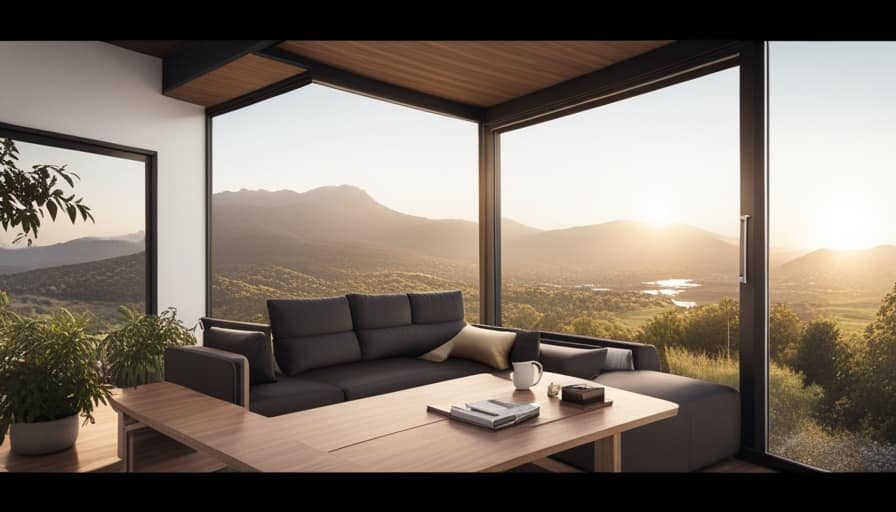
As someone living in Fresno, I have always believed in the saying ‘home is where the heart is.’ Thanks to the city’s forward-thinking housing policies, even the smallest of homes can now have a place to call their own.
In this article, we’ll explore how Fresno has embraced the tiny house movement, collaborating with advocates and implementing innovative zoning regulations. Join me as we delve into the challenges faced and the remarkable progress made towards building a thriving tiny house community in Fresno.
Key Takeaways
- Fresno has implemented housing policies and initiatives aimed at increasing access to affordable housing, including energy-efficient homes and tiny house construction.
- Collaboration with tiny house advocates is crucial for effective housing solutions, as they bring valuable insights and innovative ideas to the table.
- Zoning regulations and permitting processes in Fresno are designed to engage the community and ensure that their needs and preferences are considered.
- Fresno has created innovative tiny house communities that focus on sustainability and affordability, incorporating features such as solar panels and rainwater harvesting systems.
The Shift in Housing Policies
I’m excited to talk about the changes happening in housing policies.
One of the most pressing issues in our society today is housing affordability. Many individuals and families struggle to find affordable housing options, causing financial strain and instability.
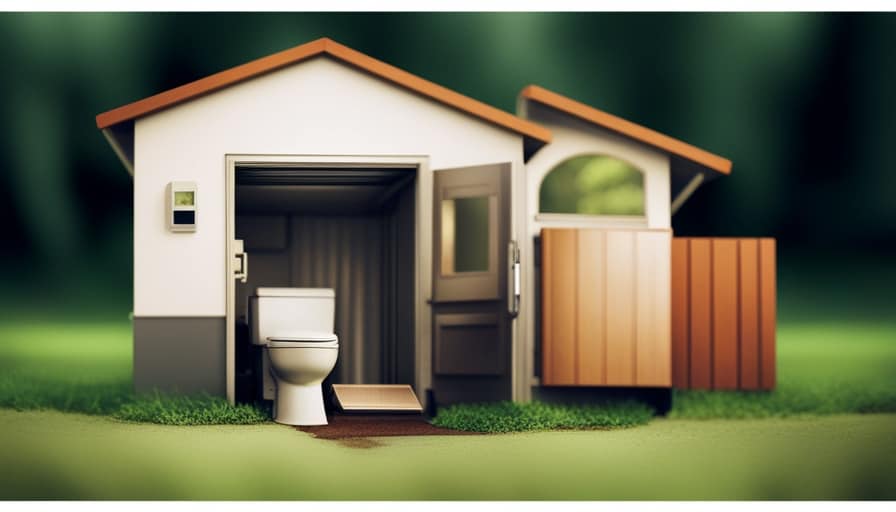
As a result, there’s been a shift in housing policies towards promoting sustainable living and increasing access to affordable housing. Governments and organizations are recognizing the importance of creating housing opportunities that are both environmentally friendly and economically viable.
This involves initiatives such as promoting energy-efficient homes, supporting the construction of tiny houses, and implementing rent control measures.
Collaborating With Tiny House Advocates
Collaborating with tiny house advocates has been crucial in implementing effective housing solutions in the city of Fresno. Through collaboration strategies and community engagement, we’ve been able to work hand in hand with advocates to address the unique challenges and opportunities that tiny houses present.
These collaborations have allowed us to tap into the knowledge and expertise of tiny house advocates, who bring valuable insights and innovative ideas to the table. We’ve engaged in open and transparent dialogues, fostering a sense of trust and understanding between all parties involved.
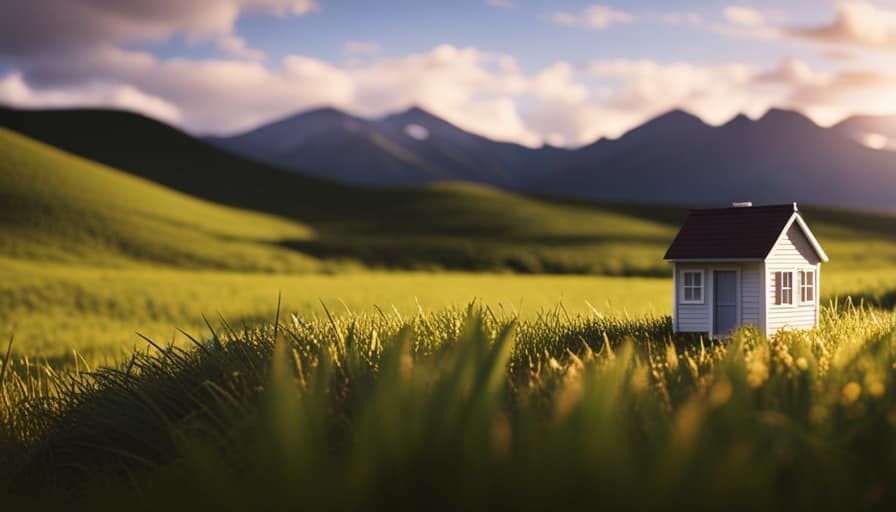
Zoning Regulations and Permitting Processes
Navigating the complexities of zoning regulations and permitting processes can be challenging, but it’s essential for ensuring the successful implementation of tiny house communities in the city of Fresno.
To streamline processes and make it easier for individuals and organizations to develop tiny house communities, the city of Fresno has taken steps to engage with the community and actively involve them in the decision-making process.
This includes hosting public meetings, soliciting feedback, and conducting thorough assessments of potential sites for tiny house communities. By involving the community in these processes, the city of Fresno can address any concerns or issues that may arise, while also ensuring that the needs and preferences of the community are taken into consideration.
This collaborative approach not only helps to build trust and support, but also allows for a more efficient and effective implementation of tiny house communities in the city.
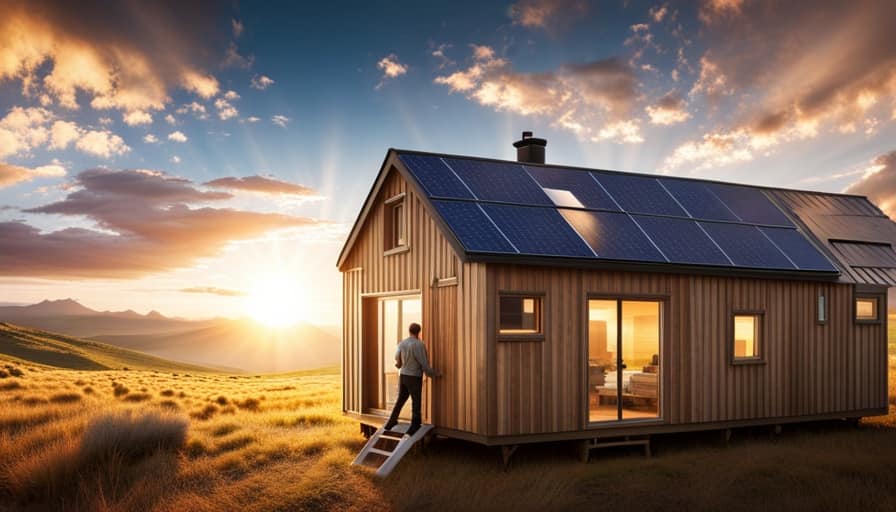
Innovative Tiny House Communities in Fresno
One innovative approach to creating tiny house communities in Fresno is through the use of sustainable materials and renewable energy sources. These communities are designed with a focus on sustainability, incorporating features such as solar panels, rainwater harvesting systems, and energy-efficient appliances. By utilizing these sustainable practices, residents can reduce their carbon footprint and live in homes that are environmentally friendly.
Additionally, these communities aim to provide affordable living options for individuals who may not be able to afford traditional housing. Through the use of smaller, more efficient spaces, the cost of construction and maintenance is reduced, making it more accessible for those on a limited budget.
These innovative tiny house communities in Fresno are paving the way for sustainable housing and promoting affordable living for all.
Transitioning into the next section, let’s explore the challenges faced in building a tiny house movement.
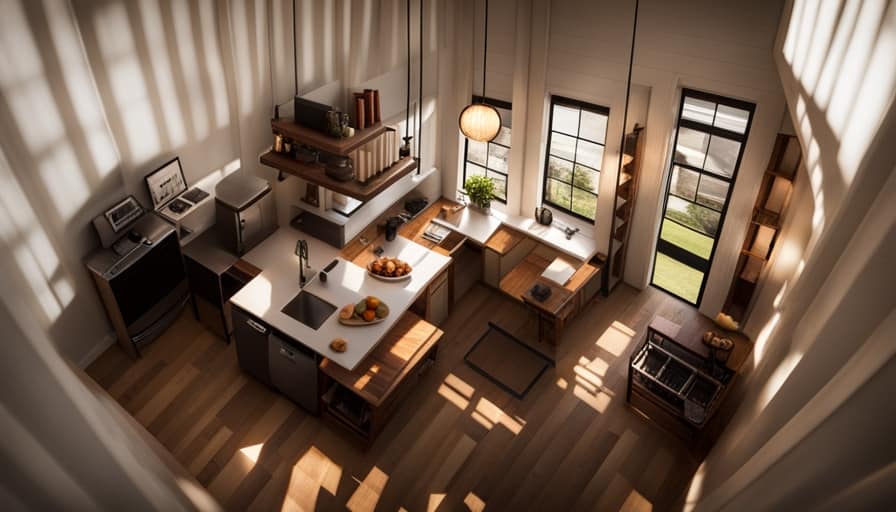
Overcoming Challenges and Building a Tiny House Movement
Confronting obstacles and working together, we can create a thriving tiny house movement in Fresno.
To overcome challenges and build a sustainable and affordable housing solution, we must first address zoning regulations. Currently, many cities have restrictions that make it difficult to build tiny houses on a permanent foundation. By advocating for changes in zoning laws, we can create more opportunities for tiny house communities.
Additionally, we need to address financing options for individuals interested in building tiny houses. Traditional lending institutions may not provide loans for these unconventional homes, so alternative financing options must be explored. Collaborating with local government, community organizations, and financial institutions can help us develop innovative solutions to overcome these challenges.
Frequently Asked Questions
How Long Does It Typically Take to Build a Tiny House?
Typically, it takes around 2-4 months to build a tiny house. The building timeline can vary based on factors like design complexity, availability of materials, and contractor availability. Cost considerations include materials, labor, and permits.
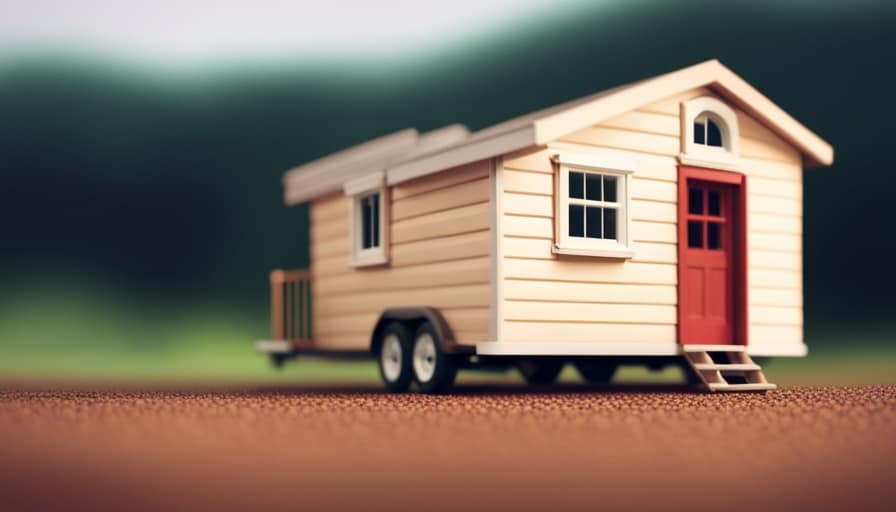
Are There Any Specific Requirements for the Size or Design of a Tiny House in Fresno?
In Fresno, specific requirements exist for the size and design of tiny houses. The city has set guidelines to ensure safety and conformity. Meeting these requirements is crucial to obtaining necessary permits and building a legally compliant tiny house.
Can I Legally Live in a Tiny House on Wheels in Fresno?
Yes, you can legally live in a tiny house on wheels in Fresno. While specific regulations may vary, other cities have implemented tiny house regulations with benefits such as affordability, sustainability, and minimal environmental impact.
How Can I Find Resources and Support for Building My Own Tiny House in Fresno?
Finding local workshops and connecting with tiny house builders in Fresno is crucial for building my own tiny house. Through thorough research and analytical thinking, I can discover resources and support to ensure a successful project.
Are There Any Financial Incentives or Grants Available for Individuals Interested in Building a Tiny House in Fresno?
There are financial assistance programs and grants available for individuals interested in building a tiny house in Fresno. It’s important to familiarize yourself with the building regulations and requirements to ensure compliance.
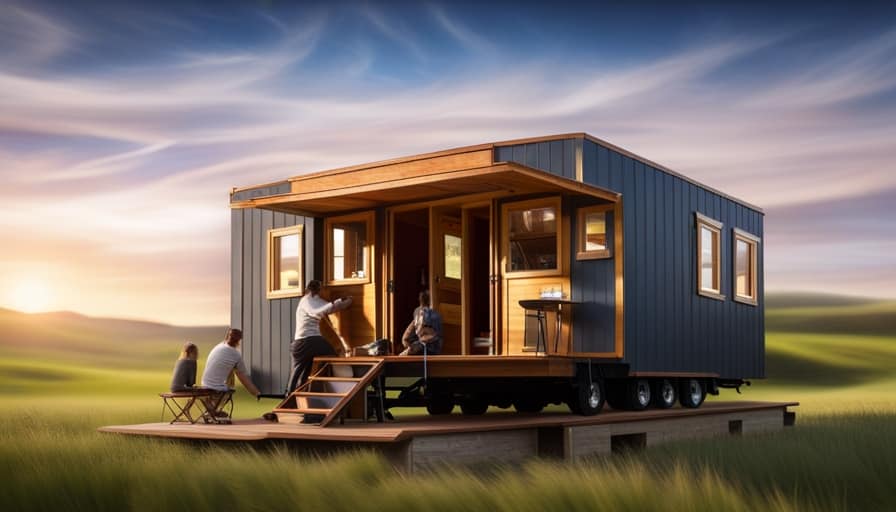
Conclusion
In conclusion, the city of Fresno has successfully embraced the tiny house movement through a shift in housing policies, collaboration with advocates, and innovative communities.
The zoning regulations and permitting processes have been streamlined to accommodate tiny house living. Despite challenges, the city has built a strong foundation for the tiny house movement to thrive.
As the saying goes, "The journey of a thousand miles begins with a single step," and Fresno has taken that step towards a more sustainable and affordable housing solution.
I’m Theodore, and I love tiny houses. In fact, I’m the author of Tiny House 43, a book about tiny houses that are also tree houses. I think they’re magical places where imaginations can run wild and adventures are just waiting to happen.
While tree houses are often associated with childhood, they can be the perfect adult retreat. They offer a cozy space to relax and unwind, surrounded by nature. And since they’re typically built on stilts or raised platforms, they offer stunning views that traditional homes simply can’t match.
If you’re looking for a unique and romantic getaway, a tree house tiny house might just be the perfect option.
Beginners Guides
How Do I Get Rid of Tiny Black Flies in My House
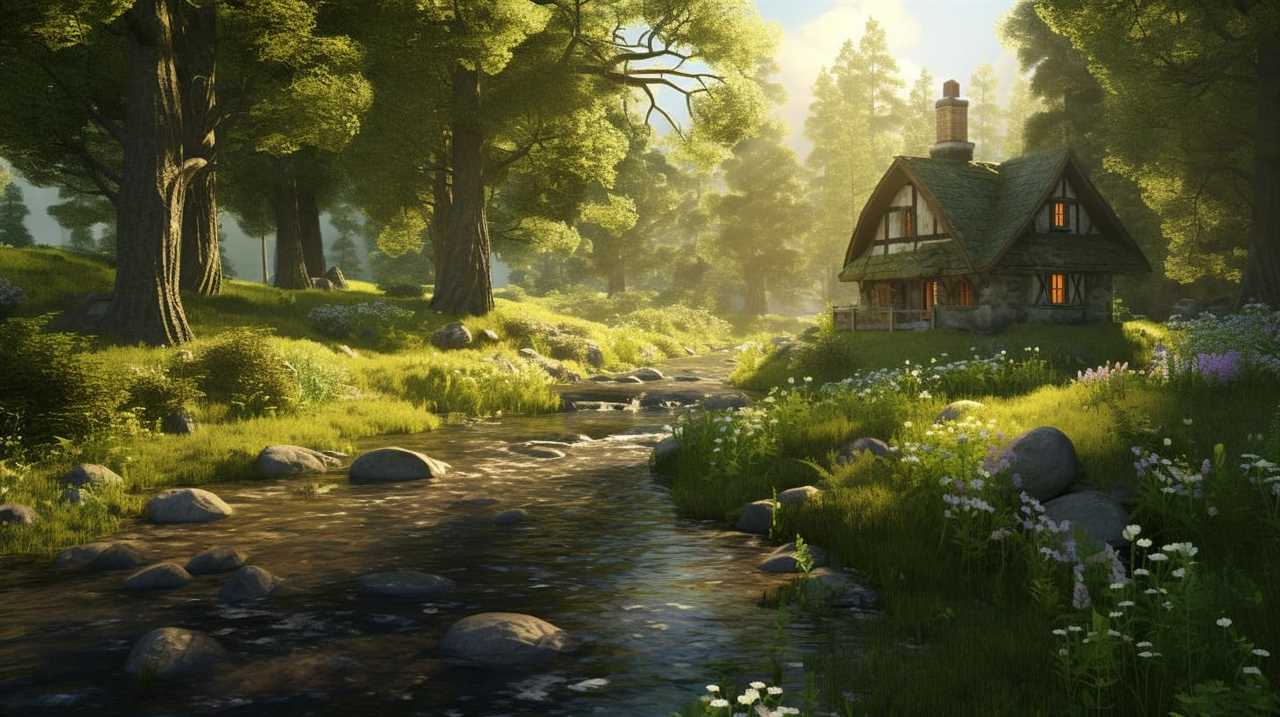
- Health risks associated with tiny black flies in the house
- Effective methods to prevent and control the presence of black flies in homes or gardens
I have tried every possible solution, but those annoying tiny black flies refuse to leave my house!
If you’re dealing with the same frustrating problem, don’t worry – I’ve got you covered.
In this article, I’ll share my expert knowledge on identifying these pesky bugs, understanding the causes of their infestations, and provide you with both natural and chemical remedies to banish them for good.
Say goodbye to those annoying flies and hello to a fly-free home!
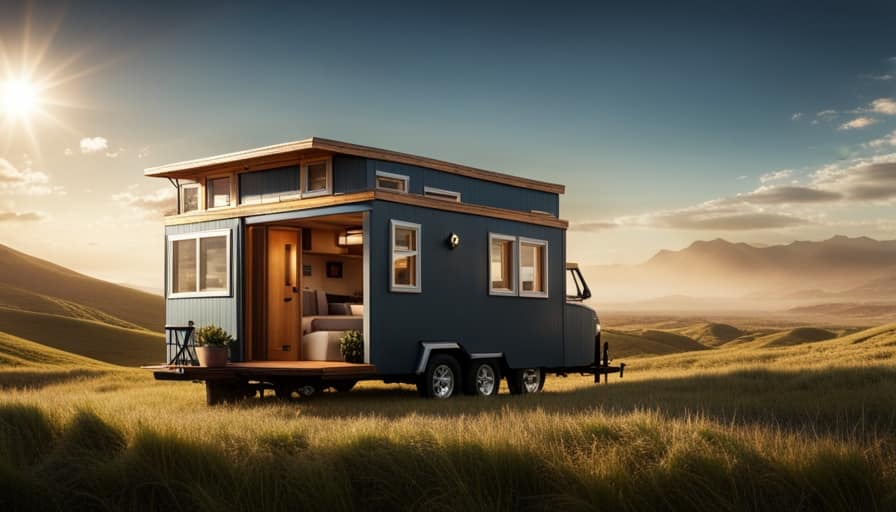
Key Takeaways
- Identify and eliminate breeding grounds by removing standing water and damp areas.
- Use natural remedies like homemade fly traps with apple cider vinegar and essential oils to repel flies.
- Consider using chemical treatments designed to kill black flies, following the instructions carefully.
- Take preventive measures to keep your house clean and free from food or organic debris to prevent future infestations.
Identifying the Tiny Black Flies
I can use a magnifying glass to examine the tiny black flies and determine their species. When it comes to differentiating between fruit flies and black flies, there are a few key characteristics to look out for.
Fruit flies are usually smaller in size, about 1/8 of an inch long, and have a tan or yellowish body with red eyes. On the other hand, black flies are slightly larger, measuring around 1/4 of an inch, and have a dark black or grayish body with dark wings.
Now, let’s move on to controlling and eliminating black flies in outdoor spaces. One effective method is to eliminate their breeding grounds by removing any standing water or damp areas where they can lay their eggs. Regularly emptying and cleaning birdbaths, flower pots, and gutters can help prevent black fly infestations.
Additionally, using insect repellents or installing fine mesh screens on doors and windows can provide some protection against these pesky pests.
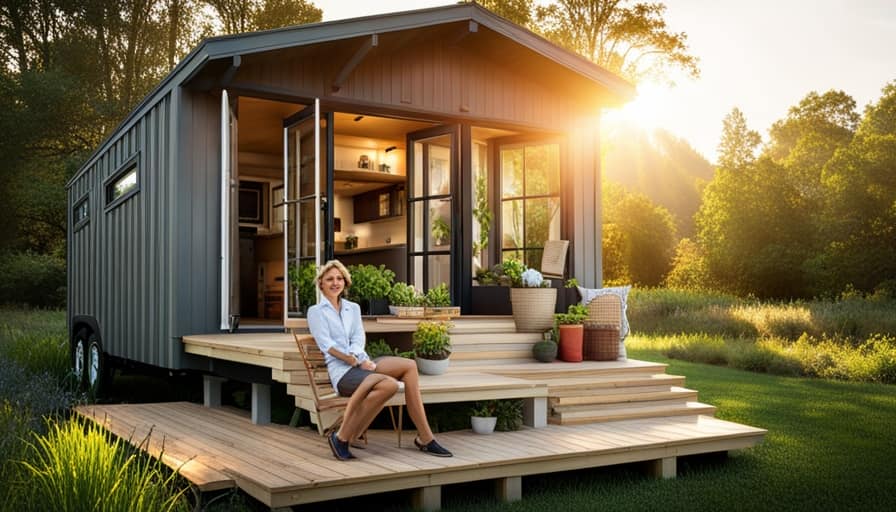
Understanding the Causes of Black Fly Infestations
To understand the causes of black fly infestations, we need to examine their preferred breeding sites and environmental conditions. These tiny pests thrive in moist and decaying organic matter, making the following places common breeding grounds for black flies:
-
Standing water: Black flies lay their eggs in standing water, such as ponds, lakes, and even puddles. It’s crucial to eliminate any stagnant water sources around your house to prevent infestations.
-
Overgrown vegetation: Black flies are attracted to dense vegetation, especially if it’s near water bodies. Trim shrubs, mow your lawn regularly, and remove any overgrown plants to discourage black flies from breeding.
-
Moist organic matter: Black flies lay their eggs in decomposing leaves, grass clippings, and other organic debris. Keep your yard clean and free of debris to reduce the likelihood of black fly infestations.
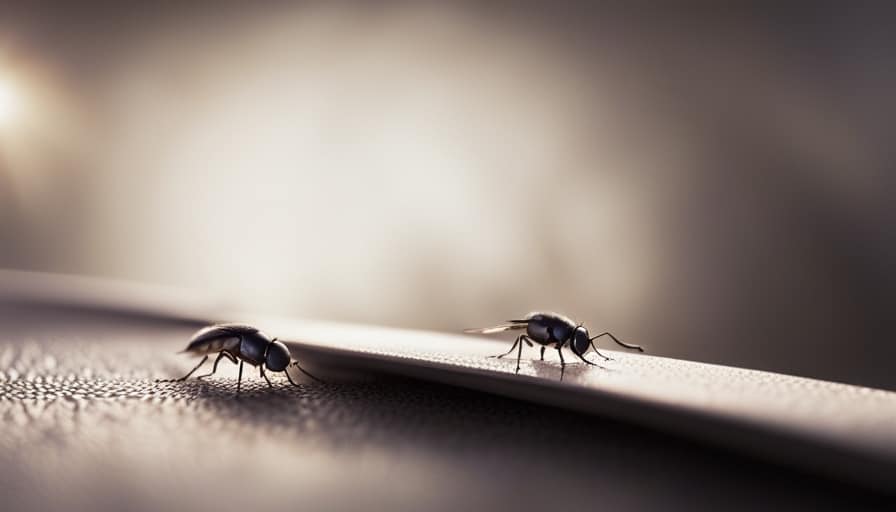
Understanding these common breeding grounds can help you identify and eliminate the causes of black fly infestations, keeping your home fly-free and comfortable.
Natural Remedies to Eliminate Tiny Black Flies
With a combination of proper sanitation and natural remedies, you can effectively eliminate tiny black flies from your house. One effective natural remedy is making homemade fly traps. These traps can be made using common household items such as apple cider vinegar, dish soap, and a plastic bottle. Simply cut the bottle in half, pour a mixture of apple cider vinegar and dish soap into the bottom half, and place the top half of the bottle inverted into the bottom half. The flies will be attracted to the scent of the vinegar, but the dish soap will prevent them from escaping. Another natural remedy is using essential oils for fly control. Oils such as lavender, peppermint, and eucalyptus have strong scents that repel flies. Simply mix a few drops of your chosen oil with water and spray it around areas where flies are present. By incorporating these natural remedies into your fly control routine, you can effectively get rid of tiny black flies in your house.
| Homemade Fly Traps | Essential Oils for Fly Control |
|---|---|
| – Apple cider vinegar and dish soap mixture in a plastic bottle | – Lavender, peppermint, and eucalyptus oils |
| – Flies are attracted to the vinegar scent but trapped by the soap | – Mix a few drops with water and spray in affected areas |
| – Simple and cost-effective solution | – Oils have strong scents that repel flies |
| – Dispose of trapped flies regularly | – Repeat application as needed |
Chemical Treatments for Getting Rid of Black Flies
By using chemical treatments, you can effectively eliminate black flies from your house. Here are three options to consider:
-
Chemical insecticides: These products are specifically designed to kill insects, including black flies. Look for insecticides that are labeled for use against flies and follow the instructions carefully. Apply the insecticide in areas where black flies are commonly found, such as around windows, doors, and other entry points.
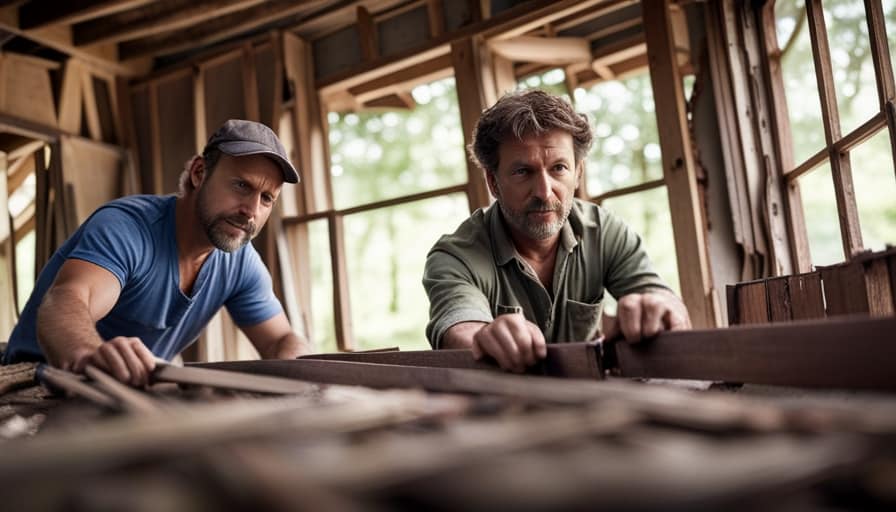
-
Fly traps: There are chemical-based fly traps available that attract and capture black flies. These traps use a combination of chemicals and pheromones to lure the flies in and prevent them from escaping. Place the traps in areas where black flies are present, such as near garbage cans or in the kitchen.
-
Professional exterminator: If you’re dealing with a severe infestation or if chemical treatments haven’t been effective, it may be best to call a professional exterminator. They have access to stronger chemicals and can provide a targeted approach to eliminate black flies from your house.
Remember to always read and follow the instructions on chemical insecticides and traps, and consider the help of a professional if needed.
Preventing Future Infestations of Tiny Black Flies
My best advice for preventing future infestations of tiny black flies in my house is to maintain proper sanitation and eliminate potential breeding grounds.
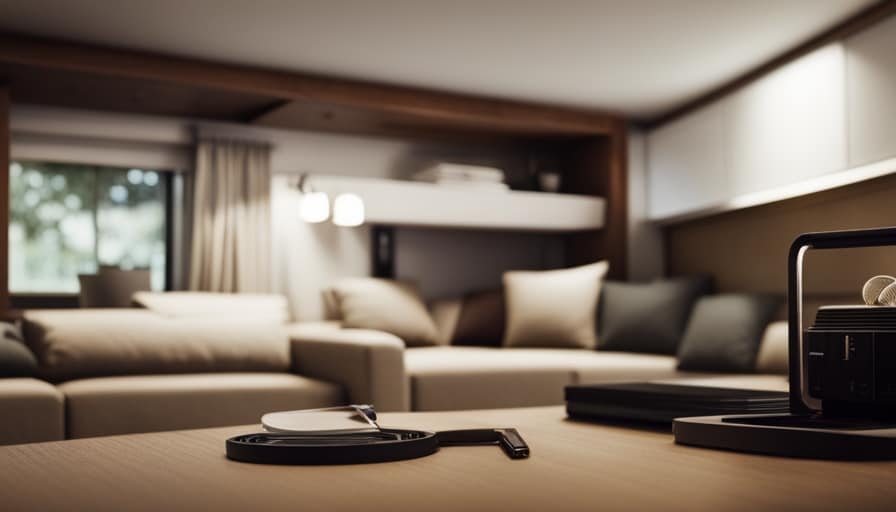
To maintain a fly-free environment, it’s important to keep your house clean and free from any food or organic debris. Make sure to regularly clean your kitchen, especially the countertops, sinks, and garbage disposal areas. Keep all food stored in airtight containers and promptly clean up any spills or crumbs.
Additionally, it’s crucial to identify and eliminate common breeding grounds for black flies in homes. These include standing water, damp areas, and overwatered plants. Regularly check for any leaks or moisture issues and fix them promptly.
Frequently Asked Questions
Can These Tiny Black Flies Harm Humans or Pets?
I’m not an expert, but I can share that tiny black flies in the house might be annoying, but they usually don’t harm humans or pets. It’s always a good idea to take preventive measures to control their presence.
Are There Any Specific Regions or Climates Where These Black Flies Are More Common?
In certain regions and climates, these pesky black flies tend to be more common. Understanding their preferences can help in devising effective strategies to keep them at bay.
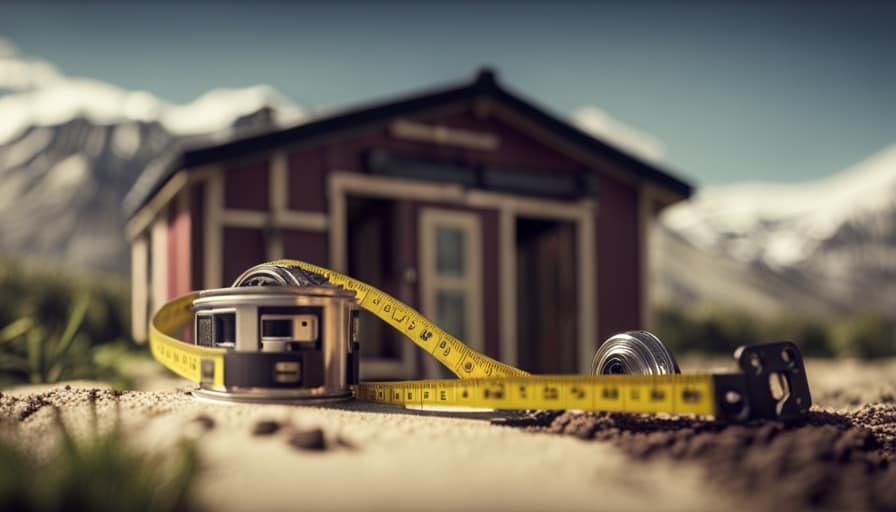
Can These Tiny Black Flies Cause Damage to Plants or Food?
Yes, these tiny black flies can cause damage to indoor plants as they lay their eggs in the soil. They can also contaminate stored food by landing on it and leaving behind bacteria.
How Long Does It Usually Take for Natural Remedies to Effectively Eliminate Black Flies?
On average, natural remedies can effectively eliminate black flies within a few days. However, the exact time may vary depending on the severity of the infestation and the specific remedies used.
Are There Any DIY Traps or Baits That Can Be Used to Catch and Eliminate These Tiny Black Flies?
There are several DIY fly traps and effective baits that can be used to catch and eliminate those pesky tiny black flies. Let me share some knowledge and details on how you can tackle this issue.
Conclusion
So there you have it, a plethora of methods to bid farewell to those pesky tiny black flies that have invaded your humble abode.
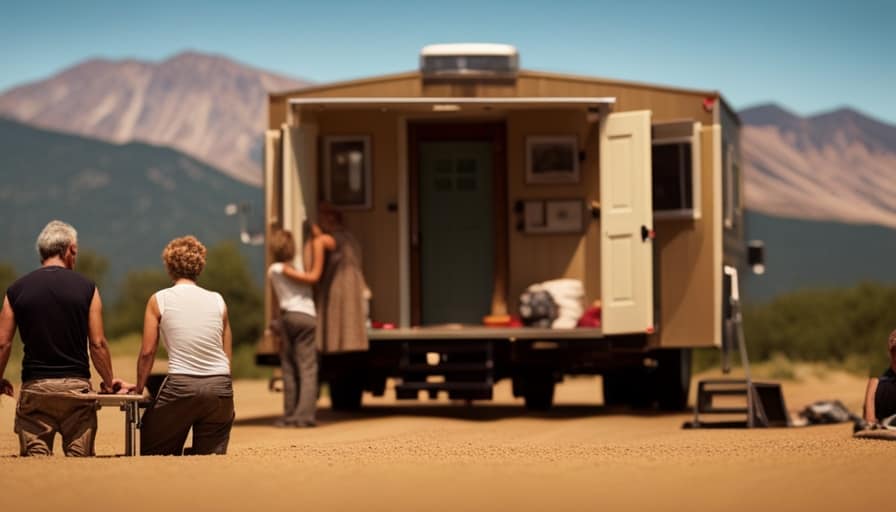
From natural remedies to chemical treatments, we’ve covered it all.
Now, armed with this knowledge, you can take control of your home and ensure these unwelcome guests never return.
Happy fly-free living!
I’m Theodore, and I love tiny houses. In fact, I’m the author of Tiny House 43, a book about tiny houses that are also tree houses. I think they’re magical places where imaginations can run wild and adventures are just waiting to happen.
While tree houses are often associated with childhood, they can be the perfect adult retreat. They offer a cozy space to relax and unwind, surrounded by nature. And since they’re typically built on stilts or raised platforms, they offer stunning views that traditional homes simply can’t match.
If you’re looking for a unique and romantic getaway, a tree house tiny house might just be the perfect option.
Beginners Guides
How Do I Get Rid of Tiny Bugs in My House

I have pests in my home that are causing me frustration! They are like small intruders that are appearing all over the place. However, do not worry, as I have conducted thorough research and found effective solutions to eliminate these bothersome pests.
In this article, I’ll guide you through identifying the types of bugs, understanding the causes of infestations, and providing natural and chemical remedies to eliminate them.
Say goodbye to those unwelcome guests and hello to a bug-free home!
Key Takeaways
- Identifying the specific pest by observing droppings or behavior is crucial in getting rid of tiny bugs in the house.
- Proper sanitation practices, such as keeping the kitchen and dining areas clean, are important in preventing bug infestations.
- Natural remedies like herbal insecticides and essential oils can be effective in deterring bugs without the use of harsh chemicals.
- Regular cleaning, sealing cracks, and maintaining a tidy home are essential in preventing future bug infestations.
Identifying the Types of Tiny Bugs in Your House
I can easily identify the types of tiny bugs in my house by observing their physical characteristics and behavior. One of the most common signs of an infestation is the presence of droppings or excrement. Different types of bugs leave different types of droppings, which can help determine the specific pest in your house.
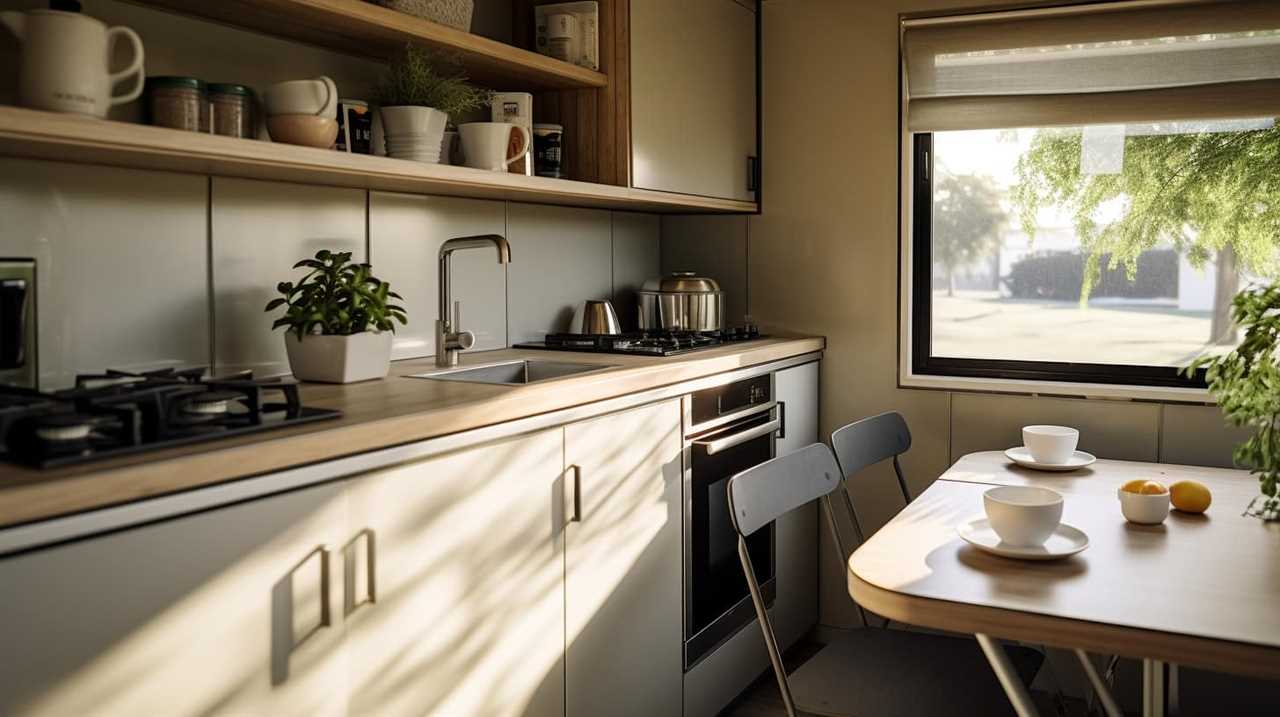
Additionally, observing the behavior of the bugs can provide valuable information. Some bugs are more active during the day, while others are nocturnal. Some bugs may prefer certain areas of the house, such as the kitchen or bathroom.
If you’re unsure about the type of bug in your house, it’s advisable to consult with professional exterminators who’ve the expertise to accurately identify and eliminate the pests.
Understanding the Common Causes of Bug Infestations
One of the most common causes of bug infestations is a lack of proper sanitation practices in the home. Understanding bug behavior and knowing their common household bug habitats can help prevent infestations.
Bugs are attracted to food sources, so it’s important to keep the kitchen and dining areas clean and free of crumbs and spills. Regularly emptying and cleaning garbage cans can also deter bugs from entering the home.

Additionally, bugs thrive in warm and moist environments, so it’s important to fix any leaks or damp areas in the house. Cluttered spaces provide hiding spots for bugs, so keeping the home organized and decluttered can help minimize their presence.
Natural Remedies to Get Rid of Tiny Bugs in Your House
To effectively eliminate tiny bugs in your house, try using natural remedies with ingredients such as vinegar and essential oils. Natural remedies are a great option for those who prefer non-toxic solutions and want to avoid harsh chemicals.
One effective natural remedy is using herbal insecticides. These insecticides are made from plant-based ingredients and can be sprayed in areas where bugs are commonly found, such as corners, cracks, and crevices.
Another natural remedy to consider is essential oils. Certain essential oils, such as peppermint, lavender, and tea tree oil, have insect-repellent properties. Simply mix a few drops of the essential oil with water and spray it around your house to deter bugs.
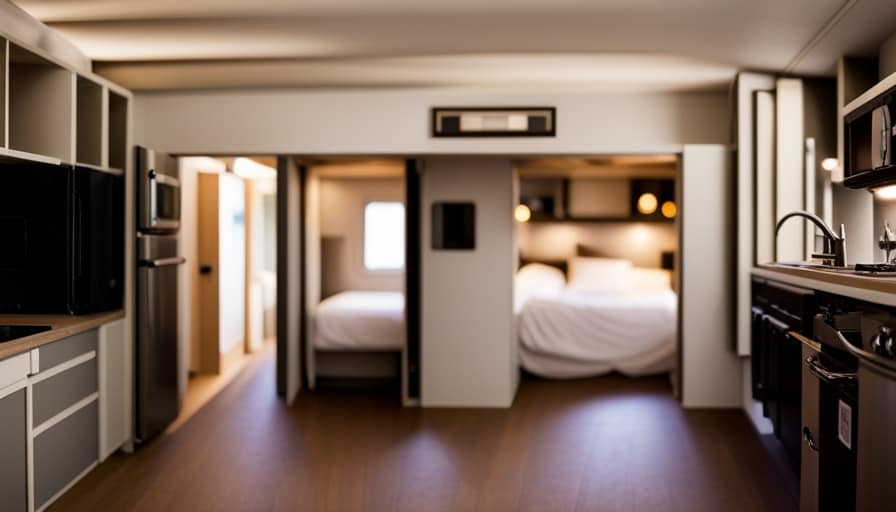
These natural remedies can be a safe and effective way to get rid of tiny bugs in your house.
Chemical Treatments for Eliminating Tiny Bugs
There are several effective chemical treatments available to eliminate tiny bugs in your house. When it comes to pest control methods, using insecticides is a common and efficient approach. There are various types of insecticides on the market, each with its own advantages and disadvantages.
It’s important to compare different insecticides to determine which one is best suited for your needs. Some insecticides target specific bugs, while others have a broad spectrum of effectiveness. Additionally, consider the application method and the duration of effectiveness. Some insecticides require direct contact with the bugs, while others can be used as a residual treatment.
It’s also essential to follow the safety instructions provided by the manufacturer when using chemical treatments to ensure the well-being of both humans and pets in your home.
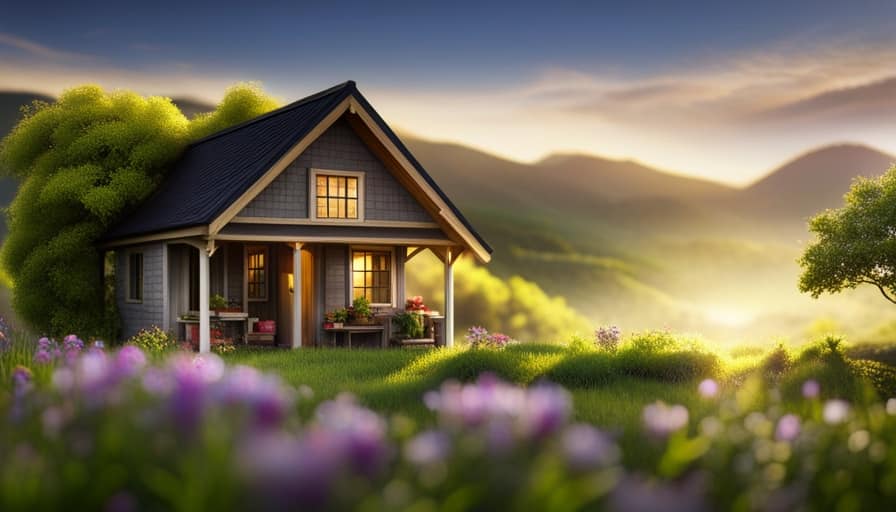
Preventing Future Bug Infestations in Your Home
I’ll make sure to regularly clean and seal any cracks in my house to keep bugs from coming in. Effective cleaning techniques are crucial in preventing bug infestations and creating a bug-free environment. Maintaining a clean and tidy home is essential to minimize the presence of bugs. Regularly vacuuming carpets and upholstery, sweeping and mopping floors, and wiping down surfaces will help eliminate any crumbs or food particles that may attract bugs. Additionally, proper food storage is essential to prevent bugs from being attracted to your kitchen. Keeping food in sealed containers and promptly cleaning up spills or crumbs will deter bugs from entering your home. Regularly inspecting and repairing any cracks or gaps in windows, doors, and walls will also help prevent bugs from finding their way inside.
| Cleaning Techniques | Maintenance Tips |
|---|---|
| Vacuum carpets and upholstery | Inspect and repair cracks or gaps |
| Sweep and mop floors | Properly store food to deter bugs |
| Wipe down surfaces | Regularly clean and seal cracks |
| Dispose of trash regularly | Keep a tidy and clutter-free home |
Frequently Asked Questions
Can These Tiny Bugs Cause Any Harm to Humans or Pets?
I’m not sure about the specific bugs in your house, but some tiny bugs can cause harm to humans or pets. It’s important to address the bug infestation promptly to protect your health and take preventive measures to keep them out.
How Long Does It Typically Take for Natural Remedies to Effectively Get Rid of Tiny Bugs?
It typically takes a few weeks for natural remedies to effectively eliminate tiny bugs. However, it’s important to note that results may vary. As for side effects, natural remedies are generally safe for humans and pets.
What Are Some Signs That Indicate a Bug Infestation in the House?
Signs of a bug infestation in the house include seeing live or dead bugs, finding their droppings or eggs, and noticing damage to furniture or walls. Preventing bug infestations involves keeping a clean and tidy home, sealing entry points, and using insect repellents.
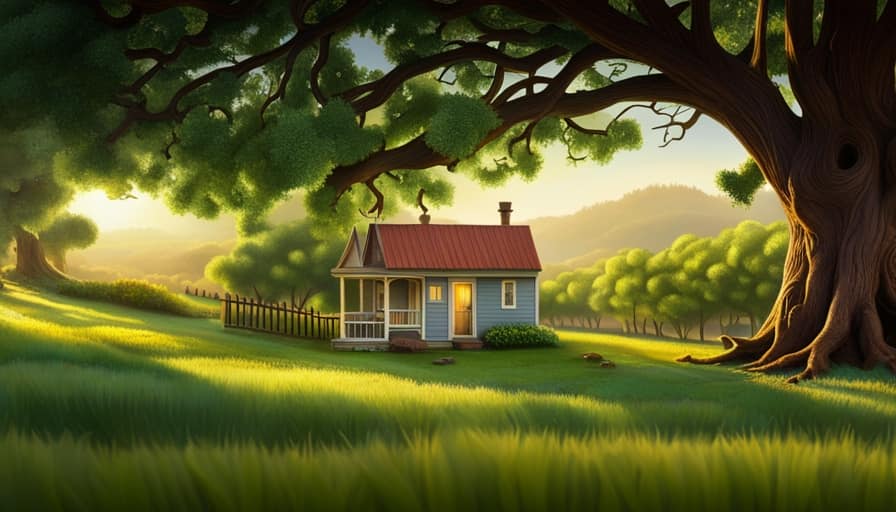
Are There Any Specific Areas in the House Where These Tiny Bugs Are Commonly Found?
In my experience, tiny bugs tend to hide in common areas like kitchen cabinets, bathrooms, and near windows. To prevent them, I recommend regular cleaning, sealing cracks, and keeping food stored properly.
Can Certain Weather Conditions or Changes in the Environment Attract These Tiny Bugs Into the House?
Certain weather conditions or changes in the environment can attract these tiny bugs into the house. Factors like warm and humid weather, open windows, and presence of organic matter can make your home more inviting for them.
Conclusion
In conclusion, while it can be frustrating to deal with tiny bugs in your house, there are effective ways to get rid of them.
By identifying the types of bugs and understanding the common causes of infestations, you can take natural or chemical treatments to eliminate them.

Additionally, taking preventive measures can help to avoid future bug infestations.
Remember, with the right knowledge and strategies, you can create a bug-free environment in your home.
I’m Theodore, and I love tiny houses. In fact, I’m the author of Tiny House 43, a book about tiny houses that are also tree houses. I think they’re magical places where imaginations can run wild and adventures are just waiting to happen.
While tree houses are often associated with childhood, they can be the perfect adult retreat. They offer a cozy space to relax and unwind, surrounded by nature. And since they’re typically built on stilts or raised platforms, they offer stunning views that traditional homes simply can’t match.
If you’re looking for a unique and romantic getaway, a tree house tiny house might just be the perfect option.
-

 Beginners Guides2 weeks ago
Beginners Guides2 weeks agoHow To Buy A Tesla Tiny House
-

 Energy Efficiency2 months ago
Energy Efficiency2 months agoBest Tiny Homes For Cold Climates
-

 Beginners Guides1 week ago
Beginners Guides1 week agoTiny House Nation Where Are They Now Stephanie
-

 Tiny House Resources (e.g., legalities, cost, insurance, FAQs)2 months ago
Tiny House Resources (e.g., legalities, cost, insurance, FAQs)2 months agoDo Tiny Homes Need Planning Permission?
-

 Beginners Guides3 weeks ago
Beginners Guides3 weeks agoFrom The Show Tiny House Nation How Many Keep Their Tiny House?
-

 Beginners Guides2 months ago
Beginners Guides2 months agoUsing a Climbing Net For Treehouse Construction
-

 Beginners Guides2 months ago
Beginners Guides2 months agoHow to Build a Treehouse Without Drilling Into the Tree
-

 Beginners Guides3 weeks ago
Beginners Guides3 weeks agoTiny House Nation Who Pays For The Houses









